When it comes to China, geopolitics and technology are linked in India’s thinking. This has resulted in bans on Chinese social media and gaming apps, restrictions on Chinese investment in India’s tech sector, concerns about telecom networks and semiconductor supply chains, and more. And India’s concerns about Chinese inroads into its tech sector are only growing. To discuss these issues, Tanvi Madan speaks with Pranay Kotasthane, deputy director of the Takshashila Institution in Bengaluru, and Trisha Ray at the Atlantic Council in Washington, D.C.
- Listen to Global India on Apple, Spotify, and wherever you listen to podcasts.
- Watch on YouTube.
- Learn about other Brookings podcasts from the Brookings Podcast Network.
Transcript
-
02:44 What are India’s concerns about China in the technology arena?
-
06:26 What are India’s concerns about China in critical and emerging tech?
-
10:50 How does India see U.S.-China technology competition?
-
13:34 Does India want the U.S. to win U.S.-China tech competition?
-
15:57 What is India’s approach to tech competition with China?
-
18:44 Second and third elements of India’s approach: Localize and liberalize, and partner with others
-
20:35 Fourth element of India’s approach: Building open platforms
-
21:42 What is India’s approach vis-à-vis the semiconductor sector?
-
25:26 How is India’s technology cooperation with global partners or within minilaterals such as the Quad playing out?
-
31:50 What balance is India striking between its desire for self-reliance and its need for partners in the technology space?
-
37:31 What balance should India strike between self-reliance and partnerships when it comes to the technology sector?
-
41:42 What should India prioritize in the future in its tech competition with China?
-
47:32 Lightning Round: What is the biggest myth you hear about India-China dynamics in the technology arena?
[music]
MADAN: Welcome to Global India, I’m Tanvi Madan, a senior fellow at the Brookings Institution, where I specialize in Indian foreign policy. In this new Brookings podcast, I’ll be turning the spotlight on India’s partnerships, its rivalries, and its role on the global stage. This season our conversations will be focused on India’s relationship with China, and why and how China-India ties are shaping New Delhi’s view of the world.
In summer 2020, two weeks after 20 Indian soldiers were killed in the clash at the India-China border, India banned TikTok as well as several other Chinese mobile applications. Since then, it has continued to ban several Chinese apps: social media apps, gaming apps, fintech apps, even dating apps. You won’t find the word “China” in any of the government notifications of these bans, but they did provide a reason for these restrictions, saying that these apps were quote, “stealing and surreptitiously transmitting users’ data in an unauthorized manner to servers which have locations outside India. The compilation of these data, its mining and profiling by elements hostile to national security and the defense of India, which ultimately impinges upon the sovereignty and integrity of India is a matter of very deep and immediate concern, which requires emergency measures.”
The timing and the reasoning of these restrictions make clear that when it comes to China, geopolitics and technology are linked in India’s mind. And this linkage and the concerns they generate go way beyond mobile phone applications to data, to telecom networks, to critical and emerging technologies, to semiconductors, and to electronic components and supply chains more broadly. Geopolitical developments are shaping India’s view that it cannot be agnostic about technology and that it does have to make choices. And technology in turn is driving and shaping competitive geopolitics.
[music]
To discuss this technology competition between India and China, today my guests are Pranay Kotasthane, deputy director of the Takshashila Institution in Bengaluru and chair of its high-tech geopolitics program, and Trisha Ray, associate director and resident fellow at the Atlantic Council’s Geotech Center in Washington, D.C.
MADAN: Welcome to the podcast, Pranay.
KOTASTHANE: Thanks, Tanvi. It’s great to be here.
MADAN: Welcome to the podcast to you as well, Trisha.
RAY: Thanks, Tanvi, for having me.
02:44 What are India’s concerns about China in the technology arena?
MADAN: Till a few years ago, we saw signs of engagement between India and China in the tech sector. We saw Chinese companies like Huawei and ZTE, or ZTE if you prefer, in India’s telecom networks. We saw Chinese apps and electronics all over the Indian market, if not dominating them. Chinese electronics as well. We also saw Chinese investment in Indian startups, in tech startups start to rise.
And then we saw in the multilateral sphere till about a decade ago, India even aligned with China and Russia on issues like cyber governance. But the mood has changed.
Pranay, today as we speak, what are India’s major concerns about China when it comes to the technology arena?
KOTASTHANE: So, the way I think of this is there are three lenses to look at India-China relations on the technology side. So, one is an “economic first” approach, the second could be a “security first approach” and the third could be a “strategic first” approach.
So, economic first approach will largely think about that countries don’t trade, people do. So, as long as the trade is beneficial to people, it should continue. So, that was the thinking that reigned before 2018, largely. And we should remember this was largely one-way technology trade because there were very few Indian companies in China. And even because of the Great Firewall, which is like a great non-trade barrier that China has, there were very few Indian content creators, for example, who had access to the Chinese market. So, that was the status quo before 2018, largely. And that reigned there was not much in terms of a policy movement to change this, even though many attempts were made.
The next lens is security first, which would argue that as long as some security concerns are addressed, Chinese companies can come in and technology trade can happen.
And the third one would be a strategic first approach, which would actually look at the long-term consequences of dependance on a major adversary, at least for the critical technology infrastructure, and take decisions accordingly.
So, according to me, what has happened is, in the last few years, starting 2018 and also Doklam, July 2017 and thereafter, the lens has primarily shifted from economic first to strategy first or security first. So, that has reigned true in a range of technology spheres, starting with telecom infrastructure, starting with apps, and also with chips. And we should remember that it’s not as though all of these are proven to have some backdoors, et cetera, but just the fact that there were military tensions that brought this primary concern, that how can you be dependent on a strategic adversary?
And I would thank Xi Jinping for that, because it brought that lens of thinking in the Indian policy ecosystem. And you know this much better than me, but this, in politics of innovation, people like Mark Pillar call this creative insecurity. Right? So, you have sort of insecurity coming from external military or economic threats, which becomes more than the internal political and economic divisions. And China brought that to India’s policy thinking. And a lot of things have turned after that, and a lot of changes have been brought to local domestic policy, which we’ll talk about later. And the motive now is to address some of these critical infrastructure dependencies in technology and get better, either through collaborations with partners or through building local alternatives.
06:26 What are India’s concerns about China in critical and emerging tech?
MADAN: Trisha, you’ve written a considerable amount about India’s technology concerns, including in critical and emerging technologies, as well as data governance issues. Tell us a little bit about how you see the concerns that India senses in this arena when it comes to China.
RAY: Thanks for the question, Tanvi. So, I do really like the framing of the outlook in India moving from an economic lens to a long-term strategic and security lens. And it’s interesting because when you look at the language of the two leaders, Narendra Modi and Xi Jinping, they use similar tones, like India and China do share the same concerns, wording like “self-reliance” and “self-strengthening.” These are common to both.
The challenge is how China goes about pursuing these goals, often at a cost to its partners and friends. There was a recent quote by my former boss, Samir Saran, where he says that China wants a multipolar world but a unipolar Asia. And I think that really rings true, especially now that we look at the last decade of how China has gone about pursuing its goals, including in the sphere of emerging technologies.
China has somewhat of a blitzkrieg strategy for emerging tech. So, there are six cutting-edge technologies that are prioritized in the 2021 Five-Year Plan. And this includes a range of tech: quantum, new generation AI, integrated chips, brain science, genetics, biotech. So, they really are pumping in a lot of investment in all these fields. In a happy world, China’s partners or its neighbors would benefit from some of this, but that’s not how the Chinese economy or its leadership really operates. It’s very zero-sum game for them.
In terms of threats or, well, concerns that India sees in this, the fact that China is pushing so hard into so many sectors means that it’s going to be a tricky pathway for India to evaluate its dependencies, current dependencies on China, and figuring out alternatives as it goes forward.
The most obvious one is, of course, telecommunications, as you’ve already mentioned in the introduction. This includes both control over networks, so that includes the content that goes through these networks. So, the ban on Huawei and ZTE was part of that. And the second concern is the devices. Chinese handsets are a big concern as well. And the Indian government has acted to an extent on some of those concerns, because even if you don’t control the networks, if you can hack into a device, you have most of the information you really need to be a security concern.
And then the second major area that you’ve seen a lot of activity in is chips. And India is hugely dependent on China for semiconductors. For example, in 2021, India imported about $5.38 billion worth of chips and $4.25 billion of that was just from China. It had grown 160% over the previous year, and India’s one of the largest growing markets for semiconductors. So, it’s evaluating, okay, what are the other sources we can look to as we diversify away from China.
MADAN: Trisha, one of the things you mentioned was content. And it’s interesting that a few years ago, in fact, prior to the 2020 crisis, when a number of these concerns came to the fore, you saw some reports of Indian government concerns about those mobile apps that you mentioned, and particularly the handsets and the default browser that came with this, which was a Chinese browser. And not just on the data side, but even in terms of the search engine results that was showing up, and some concern there, that that was manipulated in a way, or there were reports and allegations that they were manipulated in a way that the Indian government wasn’t pleased with and then imposed some restrictions. Also thanks to some reports coming about out about that specific browser internationally.
10:50 How does India see U.S.-China technology competition?
Pranay, Trisha mentioned some of the concerns, specific concerns. And as I listen to them, I think these are actually some of the concerns that the U.S. also has, that Europe also now has vis-à-vis Chinese technology and involvement in their tech sectors. Given India’s concerns and the context in which these are emerging, how is India seeing U.S.-China tech competition?
KOTASTHANE: I would say that India wants the U.S. to win that tech competition, and I think that is the lens I would see this from. And the reason why I see this is: until 2015, ‘16, when the investment in technology was largely happening from the Silicon Valley-based companies and venture capital from there, we didn’t have so much concern about the values and ethicality of that technology and the investment that is coming in. Because, with money comes also some values on the kind of surveillance it enables or the kind of practices that it takes.
But around that 2013 to 2016 period, we actually saw a lot of Chinese investments also coming in. And that was a concern for a lot of people in the sense that money is fine, it helps the tech ecosystem. But also the concern was that what will it do to the values that it writes itself on? So, that was one concern. And over time, the Indian response has been that we are more comfortable with the values that come from Silicon Valley rather than from Beijing or Shanghai.
So, U.S.-China tech competition is seen from that angle. I think Indian government fully realizes that it can’t do everything on its own. It will need to have partners and U.S. is a more preferable partner.
I would like to add, though, that I think this doesn’t mean that collaboration with China should end. In fact, I am a votary that a lot of things on technology also should continue with China, because just like China built its strength by utilizing collaboration with American companies, I think India can do a lot by collaborating with Chinese companies, including in chips. I don’t think all chips are strategic. It’s very difficult to build a backdoor without getting detected. So, we need to have a narrower definition of what is critical even in the technology space. And beyond that, it’s okay to work even with China.
But obviously, when it comes to comparison, the U.S. tech, because of the values that it comes with, because of the ecosystem that it has, is much, much more preferable. And also China is a strategic adversary, U.S. is not. So, I think that much is clear in the Indian strategic view.
13:34 Does India want the U.S. to win U.S.-China tech competition?
MADAN: Trisha, does India want the U.S. to win U.S.-China tech competition?
RAY: So, there’s a fairly famous Korean phrase which goes, “in a fight between whales, the shrimp’s back is broken.” And while, yes, the U.S. would certainly be a preferable partner when it comes to a lot of these sectors, there is also a concern within Indian policymaking circles and decision-making circles that the tech competition, if it were to escalate, could have adverse consequences for India. So, that’s not always positive for India as well.
Given the—I’m going to specifically now go back to the question on U.S.-China competition—given the pressure that a lot of U.S. companies are now facing from government, from their shareholders to engage in more deep scrutiny of their supply chains, or diversified, or China-plus-one strategies, it’s been a big benefit to India. And we’ve seen that quite concretely happening in the semiconductor space. So, you have this confluence of incentives that is working in India’s favor: the U.S. CHIPS Act, the pressure that the U.S. government is placing on chips companies, India’s semicon act as well. All of these are working to India’s benefit as well.
The other point I did want to quickly plug in on “not all tech is strategic.” The problem is that Beijing has proven capable of weaponizing all sorts of flows. And all of these connections can be vulnerabilities. So, there needs to be a deeper assessment of, okay, if China were to cut off cooperation in this area, what could India do? So, not everything needs to be strategic.
MADAN: And of course that was the idea behind the process that was set up to certify or not certify companies and equipment that could be included, for example, in India’s technology center [sic] where it was very clear that at the end of the day, what had shifted is the strategic lens going to dominate over the economic one.
15:57 What is India’s approach to tech competition with China?
I do want to get back to what I sense is a little bit of a debate on this question of how much to actually potentially collaborate with China, and we’ll get to that. But more broadly, given the concerns that the two of you have talked about, Pranay, what has the approach that India has been taking given this competition and the geopolitical situation that India has been facing? What is the approach that India has been taking?
KOTASTHANE: I would classify India’s approach into four categories. So, I’ll try to expand on each of them. But largely what you can see is things turning sharply after the Galwan crisis, like you mentioned, in May 2020. So, I’ll try to use that to illustrate what are the changes that happened during that time as well.
So, first tactic has been all sorts of restrictions and even intimidation, I would call it. So, for example, just days after the Galwan crisis, 59 Chinese apps were banned and they said they were prejudicial to the sovereignty and integrity of India, defense of Indian security, of state and public order. That was the press release. No data, no white paper was released or nothing. We don’t know what exactly were the concerns. But yes, this was the one reason which was an immediate response after the Galwan crisis.
The second, Huawei and ZTE weren’t banned, they’re still not banned, but they aren’t preferred in the 5G trials. So, in fact, before this, they were allowed in trials. So, a couple of companies were there in the trials going to collaborate with Huawei and ZTE. But around this time, around April, after that they just said that these companies can’t come in to this.
And the third one was FDI policy change. So, for example, around April of that year, there were policy changes made, such that all FDI coming in from neighbors that quote unquote share a border with India need to seek government approval. It’s only applied to China. Don’t get a lot of tech funding from Pakistan, obviously.
And the other thing also was this is just a government response. Right? But also we need to think of the response of society. So, after this happened, you saw there was a big public boycott, people throwing Chinese TVs on the street. But even now, listeners can go and check Amazon dot In storefront and every product review will have a question, “Is this made in China or not?” And if this is made in China, you get a bad ratings for it. So, that in a small way illustrates how people are also thinking about this at large. So, this was one, restrictions.
And also in recent days, there has been a lot of intimidation in various ways. There have also been tax raids, et cetera, on Chinese companies, mobile phone-making companies, for genuine reasons. But this is one broad approach—so, restrictions and intimidation.
18:44 Second and third elements of India’s approach: Localize and liberalize, and partner with others
The second one is localize and liberalize. That approach, what it talks about is, again, that we need to do things domestically, and if it also means changing policies to liberalize, we should do it. So, another example of this is on 5th May the border clashes began in Ladakh. On June 15 there was that incident where the life of 20 Indian soldiers was taken. And during that time the satellite imagery displayed in the public domain came from constellations of private companies in the West. And that was one last element which led to a space sector liberalization.
So, on June 24th, we had the Union Cabinet approve the private sector participation in space activity. So, until now space activities were closed, and only ISRO’s [Indian Space Research Organisation] was the main driver, with some private companies being their vendors. But this was a full-scale liberalization of the space sector, which very few people had expected, but that went through immediately after this.
The next thing was the PLI scheme, which is production-linked incentives, in order to encourage local manufacturing—by MNCs [multinational corporations], by Indian companies, doesn’t matter. So, that, again, electronics was the first PLI, which was launched by the government, again in 2020, around this area. So, this is second category localize and liberalize.
The third one is partner with others. So, Tanvi, you follow the India-U.S. relationship much better than I do. But just, if you see the NSAs’ meeting which happened in Jan and then the Modi-Biden summit, the amount of references about technology in the joint statement, I don’t think I would have imagined that even four or five years ago. The first statement was on semiconductors in the joint statement. That doesn’t happen.
So, I think Indian government also realizes that you need to have partners along to go there. So, self-reliance completely is not an option. That is the third one.
20:35 Fourth element of India’s approach: Building open platforms
And the fourth one is building of open platforms. That is also an Indian approach that we have taken. So, for example, open architectures for payments, identity, et cetera, is what in India we call digital public infrastructure. That has been one big statement by India in the G20 summit as well. And it wants this idea, which is open—you can opt in, you can opt out—to be taken in other countries.
Similarly, on semiconductors, the Indian government also backs the RISC-V Foundation which is an alternative to ARM instruction set architecture. Again, one company which dominates that entire ecosystem of instruction set architectures on mobiles processors. So, that is a second one.
And the third one is Open RAN, again another alternative for telecom infrastructure which is unbundling all the layers which come up in telecom infrastructures, so can they be unbundled so that there are different players and you are not dependent on a single player. So, that is the fourth idea.
So, I think these are the four broad responses I can gather from what has happened in the last few years.
21:42 What is India’s approach vis-à-vis the semiconductor sector?
MADAN: Trisha, do add to that list, differ if you if you want, but also you could talk also a little bit about what India’s approach to the semiconductor sector has been in particular, given its dependence, as you mentioned earlier.
RAY: So one, I just want to reiterate how fascinating it is to see how emerging technologies have emerged as a cornerstone of the U.S.-India partnership. And even in the recent 2+2 ministerial dialogue there was quite a lot of mention of emerging tech and science cooperation.
Now, in terms of how Delhi has been responding to the changing geopolitics around technologies, I do also want to reflect on the point that, yes, Galwan was a turning point, but it is not like the Indian government had not expressed concerns about Chinese apps, Chinese devices before. In fact, during the Doklam crisis, a few years before that, the Defence Ministry had issued instructions to its soldiers on the border to uninstall a series of Chinese apps. So, there was a precedent for some of this before the full-scale ban of Chinese apps that happened after Galwan. So, this did not really come out of nowhere.
And then there’s also been a lot of activity from the Chinese side in the cyber realm. For example, a lot of Chinese threat actors, advanced persistent threat actors, have been active around Indian infrastructure grids, like the electricity grids. And this also has been happening for a little under a decade now. So, these were all concerns that had been building before the inflection point that Galwan became.
In terms of specifically talking about what I see as a sunrise sector, even for the U.S.-India partnership, which is semiconductors. Like I was mentioning before, for India what has worked in its favor is is this confluence of incentives: the U.S. CHIPS Act, and the incentives that it provides to chips companies. Then India’s semiconductor incentives from both the central government, as well as each state government having its own subsidies and incentives that it is offering to companies who are interested in India. This includes simple things like electricity subsidies, water subsidies, favorable rates on land. All of this has really worked to get all of the semiconductor investments that we’ve seen in the past year into the country as well.
And of course, the momentum is driven by leadership on both sides as well. I have not seen things move this fast in bureaucracy before—as fast as they have, especially in the semiconductor space. So, that has been really encouraging to see and should hopefully set the tone on future, say, electronics cooperation between the U.S. and India as well.
MADAN: It is interesting, as you said, on the U.S.-India side, that technology historically—after an initial period in which the U.S. played a role in conjunction with Indian scientists and technologists in really facilitating India’s space program, but also its nuclear program. You did see some of that in the beginning, but after that, you really saw a period in which technology was a source of friction in the U.S.-India relationship, thanks to export controls and resentment about that. And now seeing really technology becoming a fuel in the relationship has been different.
25:26 How is India’s technology cooperation with global partners or within minilaterals such as the Quad playing out?
Both of you have also worked on thinking about how technology cooperation plays out in groupings or minilaterals like the quadrilateral, the Quad with Australia, India, Japan and the U.S. How do you think a Quad or, say, partners other than the U.S. for India can be helpful or not? How does India see this other range of partnerships, but also these new issue- or interest-based coalitions as playing in this arena?
KOTASTHANE: So, the way I put this is that multilateralism is a necessity and not a choice in technology areas, because you cannot have national champions which can do everything across a supply chain. The supply chains are too complex. You can’t have what you could do with, for example, for steel manufacturing in the past: that you have a steel industry which can be built completely ground up in one nation state. So, you will need to specialize in some parts of the supply chain. So, for that reason, multilateralism is really a necessity.
The way I see this is that the goal should be not about completely having your own local ecosystem, but the fact that you need to essentially have two goals in mind in the technology realm. One, that together with your partners, you should be able to collectively have presence across the supply chains. So, that is one goal.
And second goal, you don’t want any one segment of that entire supply chain to be dominated completely and entirely by an adversary of yours. So, as long as you’re satisfying these two goals, you don’t need to do an entire national semiconductor supply chain, national AI chain, national telecom infrastructure chain. So, that is not what is required.
And that is the approach which most countries are taking. Right? So, U.S. also has a Chip 4 Alliance with South Korea, Japan, Taiwan. India is also talking about that with respect to the Quad.
So, I think it is supremely important because we have to think from the lens of strengths and weaknesses, complementarities. You can’t do everything on their own, and that’s why minilaterals are very important. I particularly think Quad is useful because one, the political goal is clearer, and second, it’s a small enough group to get something done without being lost into the intricate details of what you want versus what I want.
So, in that sense, that’s why I was quite so happy that Quad had the semiconductor supply chain initiative announced. And there is a lot more to be done on that. And in fact, again, there’s a lot of action in the Quad on the technology side rather than the other side, the military, et cetera. So, I do think there’s a lot that minilaterals can do and they are necessarily required. It can’t be done by one nation state alone, including the U.S.
MADAN: Trisha?
RAY: I want to repeat something that Pranay had said in the beginning, which is a big thank you to Xi Jinping, because a lot of the reason that the Quad has been so active, and honestly the list of deliverables has been fairly impressive, is in part because of Chinese aggression. Though, of course, within the Quad there is a debate as to whether being anti-China is enough to sustain cooperation, but it has been certainly very beneficial so far.
In terms of the value India sees in some of these partnerships—and yes, Quad has been more stunning in the just the progress that it has made—one, I would say is that the Quad is also somewhat of a launchpad for broader cooperation within the Indo-Pacific, especially cooperating with ASEAN and other countries in the region. Because if we look at the economics of the region, ASEAN is one of the fastest growing economies as well. So, having them being part of this conversation, even with the many differences within ASEAN on China, it’s an important issue for India as well.
The second value would be that India has always sought to engage in international forums in a way that reflects its own interests, and that is also now true of technology standards. And having a forum like the Quad to express its viewpoints and then present some of a unified front at some of these forums is also useful.
Though of course, there are times when India’s interests may not always align. And there’s an interesting case in the 5G space where India proposed its own set of 5Gi standards, which was completely contrary to the discussions that had been happening in the Quad 5G working group. That was pretty quickly resolved. But that was certainly an interesting case in point in how India can sometimes go its own way.
And then the third value is, again, and something that Pranay has mentioned, which is in taking Indian technology solutions to the world as well. And digital public infrastructure [DPI] is one of these. We’ve seen DPIs mentioned now in the Quad leader statement, as well as being a very prominent part of India’s G20 presidency. So, these are the three main utilities or values that I think India sees in these relationships.
MADAN: A couple of things on the Quad, you know, as you said, thinking about the digital and technology side, the Quad offering alternatives, higher quality alternatives, particularly with financing, which has been a complaint in many countries, who were saying, yes, you’re telling us don’t use Chinese companies, but what is your alternative and how are you going to help us deploy it? And so, I believe it’s in Palau that—the Pacific island state—where the Quad is going to have a roll out of this Open RAN alternative. And we’ll see how that develops.
And when Xi Jinping is mentioned in the Quad—Abe Shinzo of course, the Japanese prime minister considered the godfather of the original Quad—but, if you think about the Quad revival ten years after, in 2017, I think the real “Quadfather,” so to speak, really is Xi Jinping. You can give credit to everybody else, but China’s assertiveness under him has been a driver. So, it’s been the necessary—though not, as you said, Trisha, the sufficient—condition for the Quad to function.
31:50 What balance is India striking between its desire for self-reliance and its need for partners in the technology space?
I do want to pick up on something, Trisha, you spoke about, which is some of these differences. Now, I almost quipped when Pranay said that India would like the U.S. to win U.S.-China tech competition, that if there’d been an Indian minister—either the external affairs minister or another—they would have probably said, if you asked them do you want U.S. to win or China to win, they would have said we want India to win.
And this reflects this, not just differences on specific issues—for example, how India sees data differently, data governance differently—but this general tension between the two terms that, Pranay, you mentioned, “localize” and “liberalize,” which has existed across the board, this is not new, which is this idea that India needs to have independent options.
Now, we’ve seen a slight shift, right? We’ve seen a slight shift where they’re saying self-reliance doesn’t mean self-sufficiency, it means resilience. It means diversification. But nonetheless, there does seem to be this tension, even as India has partnered with other countries, between this tendency to localize and liberalize, to build national champions or to welcome international MNCs. And this does show up in various spaces.
Pranay, what do you think of this kind of tension and what is the balance that India is striking between this traditional desire for self-reliance and this need for partners? And what do you think this balance should be?
KOTASTHANE: I agree with you. I don’t think Indian policy is striking the right balance at this moment. And the way I would frame it is, currently there is a lot of tendency to localize and globalize together simultaneously. And the way it manifests itself is, for example, we have very high import duties and they have risen in the last four, five years. So, a lot of MNCs have said that how can we do world-class manufacturing and export competitively if you’re going to have very high import tariffs? Because not every component can be made in India on day one, it will require many years to be able to do that. Right? So, the idea is a low-import tariff regime is necessary.
So, there was a great report by ICRIER [Indian Council for Research on International Economic Relations], an economic think tank, which said that India needs to first globalize and then localize. What it means is you embed yourself into the global supply chain first and then think of building local capability, et cetera. I mean, focus on that primarily comes later. But Indian policy has often been to do this simultaneously, and that’s why our tariff structures are some of the highest in the world, even if you compare it to countries like Mexico, Thailand, and Malaysia, et cetera, not just China and Vietnam. So, that is one concern.
The second one, like you pointed to, data localization, is another issue that came in. But now it has been resolved with a new bill on data protection. Data localization is not that big a concern. There is a blacklist, you can say, of countries which India wouldn’t want to have data sharing with, but largely all other countries it’s fine. Right? But it was not the case in the original draft of the bill where there was a strong emphasis on data localization. So, again, you see a transition from a very state-centric view and localization to a more rational view.
The third angle I would say where India is really lacking is private sector R&D funding in India is abysmally low. A lot of people think the problem is with government funding in R&D, which is actually not the case. If you normalize for India’s GDP, GDP per capita, in India’s government sector, R&D funding is quite good.
But what the concern we have is that there have been very few companies which have been able to transition from being product makers or service makers to making excellent products in technology area which can go global, and especially in hardware, et cetera. So, you can think of Micromax, et cetera, importing Chinese phones, white label phones, putting their logo and making lot of profit. But they were not able to transition to doing great stuff on their own. So, this is a concern.
So, a lot of focus needs to be on why private sector R&D funding is low in India. And I am not just talking about startups. Even the top ten companies by revenue in India spend very little on private R&D. So, this is the balance I would say is required.
The fourth and final one I would say is just the fact that we need to be part of the global supply chains. You can’t isolate yourself, so for example, there is the information technology agreement of the WTO which said that all electronics, hardware, et cetera will be zero tariff going ahead. But India is not a signatory to ITA2, not a part of the discussions in ITA3. We are also not part of our RCEP.
So, there are a lot of these core technology ecosystems of which India’s isolated itself, thinking that we can do a lot of things on their own. And now we are trying to sign many FTAs with separate countries. But there are time and opportunity costs involved, right? Like FTAs don’t happen in quick time. So, it will take a long time before we are able to reap the benefits. And by that time, you might not have this moment where there’s a confluence of factors, as Trisha said. So, I think these are the changes that are sort of required.
MADAN: RCEP, for those listeners who don’t know, is the Regional Comprehensive Economic Partnership, which India withdrew from the negotiations for in 2019.
37:31 What balance should India strike between self-reliance and partnerships when it comes to the technology sector?
Trisha, what do you think is this balance? What are the differences that India does have with otherwise generally like-minded partners or as the Indian government calls them, trusted geographies? Where do you come down on this question of what the right balance should be?
RAY: This struggle between protectionism and being connected to the world has marked India’s history since independence. And I can even go back to a particularly Nehruvian phrase, which is inculcating a scientific temper within the Indian population—where the idea was that we can’t just import technologies, we have to import the knowledge with it so that it empowers the Indian people. And I think that sentiment continues to that day, including in some of the more contentious like IP (intellectual property) issues that become somewhat challenging in the U.S.-India relationship.
I would also say that the Indian government is not a monolith. So, different ministries, different leaders, different bureaucracies have different views on the correct balance. And I think some of those disagreements might be confusing from the outside, but you know that there is an active debate going on within government.
And then I do see that there is a trend towards comfort and reliance on other partners that you trust. And we’ve seen that, yes, particularly in the Quad relationship, but especially in the U.S.-India and India-Japan partnership as well. We don’t talk about the India-Japan partnership a lot, but the technology element of that has been quite interesting as well, including in some of the railway infrastructure projects that the Japanese have helped India build.
I do also want to go back on the really important point that Pranay made about private sector investment. I think part of that is because the risk tolerance of Indian private sector entities is really low. The funding issue is also a problem in some of these basic science and basic areas of research, and that we see in academic funding, like universities are also in desperate need of funding. That’s especially important, for example, in quantum technologies where a lot of universities are still waiting on basic components for their research because funding is held up. Or there’s some trade restriction somewhere and their parts are just sitting in a port awaiting some approval.
And then finally on India sometimes not exactly aligning with its partners, where its interests may be in slight contradiction. Perfect alignment is impossible, even amongst the closest of allies who’ve been sharing information with each other for decades. And as we’ve already mentioned in this conversation, India’s partnership with the United States is really in its adolescence, if not its infancy, in the scheme of things.
MADAN: And I think this concern India has and this desire to be independent, yes, it’s part of the strategic culture—every government has had it, Indian business has talked about it. But it also does, I think, in some ways come from that lived experience, particularly with the U.S., but also with other countries. What’s interesting is the lived experience that gets remembered is, oh, you know, India has been sanctioned by others and cut off from technology. What people have often forgotten about the lived experience is it was an initial stage of collaboration in the ‘50s and ‘60s with Western countries—the U.S., France, U.K.—in the tech sphere that really did help encourage and facilitate and operationalize that scientific temper that even Nehru talked about. And then after that, the Soviet Union.
So, India, yes, it’s the imagination that the self-reliance has been self-sufficient, but it’s always been fueled by partnerships at crucial and critical times. And unfortunately, that part gets forgotten.
41:42 What should India prioritize in the future in its tech competition with China?
Both of you have brought up some of the things that India needs to do already, but as we think about the future, are there other things that you think, given its technology competition with China, India needs to prioritize and focus on? Pranay?
KOTASTHANE: Yeah, I would just try to also say that you need to take advantage of the adversary as well. So, I would say actually for building a lot of local capability, you might need to take help of Chinese companies as well. And I think we should do it. For example, India’s FDI policy: what it did, as I said, was restrict investment in the Indian tech sector. But Apple—and Apple is the poster child of India’s electronics production-linked incentive policy—most of Apple’s supplier and manufacturers are Chinese. So, eventually the government had to modify the FDI policy to allow some of the Apple suppliers and vendors in China and allow them to come in and make partnerships with Indian companies and let them make products. So, either phone displays and things like that here.
So, that’s the one angle I would like to add: that there are still areas of cooperation beyond, like maybe telecom infrastructure is a no-go area because you can’t give that entire critical infrastructure to your adversary. But there are many areas where not every chip is strategic, as I said. It would be very difficult for China to engineer the chips coming into India only and not do that for the entire world, and not be caught. It can be easily caught. There are technical ways to catch these kinds of things.
So, from that lens, I also feel there is some space that we will have to collaborate, only from a national interest perspective, to build capability quickly. You can’t isolate and think that we would be able to do this entirely on our own.
MADAN: You’ve also seen the Indian government, I think, recognize that not just on allowing some of this investment or companies in, but even things like visa policies, giving visas to certain Chinese individuals who have specific areas of expertise. And I think this is something, this idea—and the entrepreneur Vinayak Dalmia mentions this—that there’s always focus on tech transfer, but it’s really, if you think about it more broadly as knowledge transfer even more crucial. And Pranay, as you said, take advantage of your adversary in this space. And we’ve seen some not liberalization, at least flexibility on that. And I suspect we’ll see it, especially in other sectors potentially like EVs, where the Indian government is also considering making some exceptions.
Trisha, anything you want to add? And if you do disagree with Pranay on giving the Chinese companies and capital and technology more leeway, feel free to disagree. We don’t mind disagreement on the podcast.
RAY: I do disagree, but I’d rather not end on a combative note. Looking forward, I think a couple of things that the Indian government specifically could do. One is that there needs to be a strategy. A blitzkrieg strategy like China has, as in you’re just investing everywhere and everything all at once is not going to work. So, what are our competitive advantages? And for that, there needs to be a stocktaking exercise. And I don’t think that has fully happened within government.
The second major area that the government could certainly work on is perception management. So, there was a survey a couple of months ago that Pew released on views of India in 23 countries. And interestingly, yes, more people have a favorable view than not. But in many countries, a favorable view of India has declined over the last decade. And so that perception point is important, especially as India seeks new partnerships in the emerging technology space. A funny line from the survey was “Indians are more likely than others to believe India’s power is on the rise.” And I think that is tragic. India’s power is on the rise. And other partners also need to recognize that. And there is a role of Indian embassies and local missions in forging those local partnerships, building trust, and changing that perception of India.
MADAN: The one I’d add is that I think Indian business, particularly big business, I think needs to be more open to that globalization point. And I think government often gets blamed for protectionism. But Indian companies at times have also been happy having their markets protected. I was a child of the ‘80s in India and we saw in the ‘90s when there was liberalization there were Indian companies who didn’t like the markets being opened up. But they actually benefited tremendously. Their net worths have gone up. And so, to actually see as much as the Indian government is seeing, this collaboration and this openness as an opportunity and not just a kind of the threat of competitors. Because they can compete, I think, and particularly with their knowledge of the Indian market.
We’ve already seen some changes. The ones I always like to highlight is a few years ago we had the head of a major Indian conglomerate talk about data colonization. And then we saw the head of a startup talk about we don’t want global companies coming in, we just want global capital. And both of those individuals subsequently signed deals. One, selling his entire company to a foreign firm and the other getting a boatload of investment from another American technology company. So, you know, you are seeing some change, but I think that’s what I would add on the list.
47:32 Lightning Round: What is the biggest myth you hear about India-China dynamics in the technology arena?
Pranay and Trisha, you’ve spent a considerable time with us explaining this China-India tech dynamic. I do want to end, as we end all episodes with asking each of you our lightning round question, which is, what is the biggest myth or misunderstanding you hear, whether in India or abroad, about India-China dynamics in the technology arena? Pranay, I’ll start with you.
KOTASTHANE: I would say misunderstanding it is that every tech dependency is a strategic vulnerability. I think it is not.
MADAN: See this is why we really should have got this Trisha-Pranay debate going. Maybe we will have to do a segment or a follow up at this point and get that combative disagreement. But Trisha, what is your myth or misunderstanding?
RAY: I’d say the misunderstanding is that there’s a tendency really to compare China and India and seeing India as an imperfect substitute for China, especially as we’ve seen this recent wave of reshorings. Obviously, the ecosystem is not going to be the same, but India stands on its own as a promising partner in emerging technology as well.
[music]
MADAN: With that, thank you very much to both of you for spending this time with us explaining these sometimes very complex issues to our listeners. Pranay, thank you for joining the podcast.
KOTASTHANE: Thanks. It was great fun. Thank you.
MADAN: Trisha, thank you to you as well.
RAY: Thanks a lot, Tanvi.
MADAN: Thank you for tuning in to the Global India podcast. I’m Tanvi Madan, senior fellow in the Foreign Policy program at the Brookings Institution. You can find research about India and more episodes of this show on our website, Brookings dot edu slash Global India.
Global India is brought to you by the Brookings Podcast Network, and we’ll be releasing new episodes every two weeks. Send any feedback or questions to podcasts at Brookings dot edu.
My thanks to the production team, including Kuwilileni Hauwanga, supervising producer; Fred Dews and Raman Preet Kaur, producers; Gastón Reboredo, audio engineer; and Daniel Morales, video editor. My thanks also to Alexandra Dimsdale and Hanna Foreman for their support, and to Shavanthi Mendis, who designed the show art.
Additional support for the podcast comes from my colleagues in the Foreign Policy program and the Office of Communications at Brookings.
The Brookings Institution is committed to quality, independence, and impact.
We are supported by a diverse array of funders. In line with our values and policies, each Brookings publication represents the sole views of its author(s).

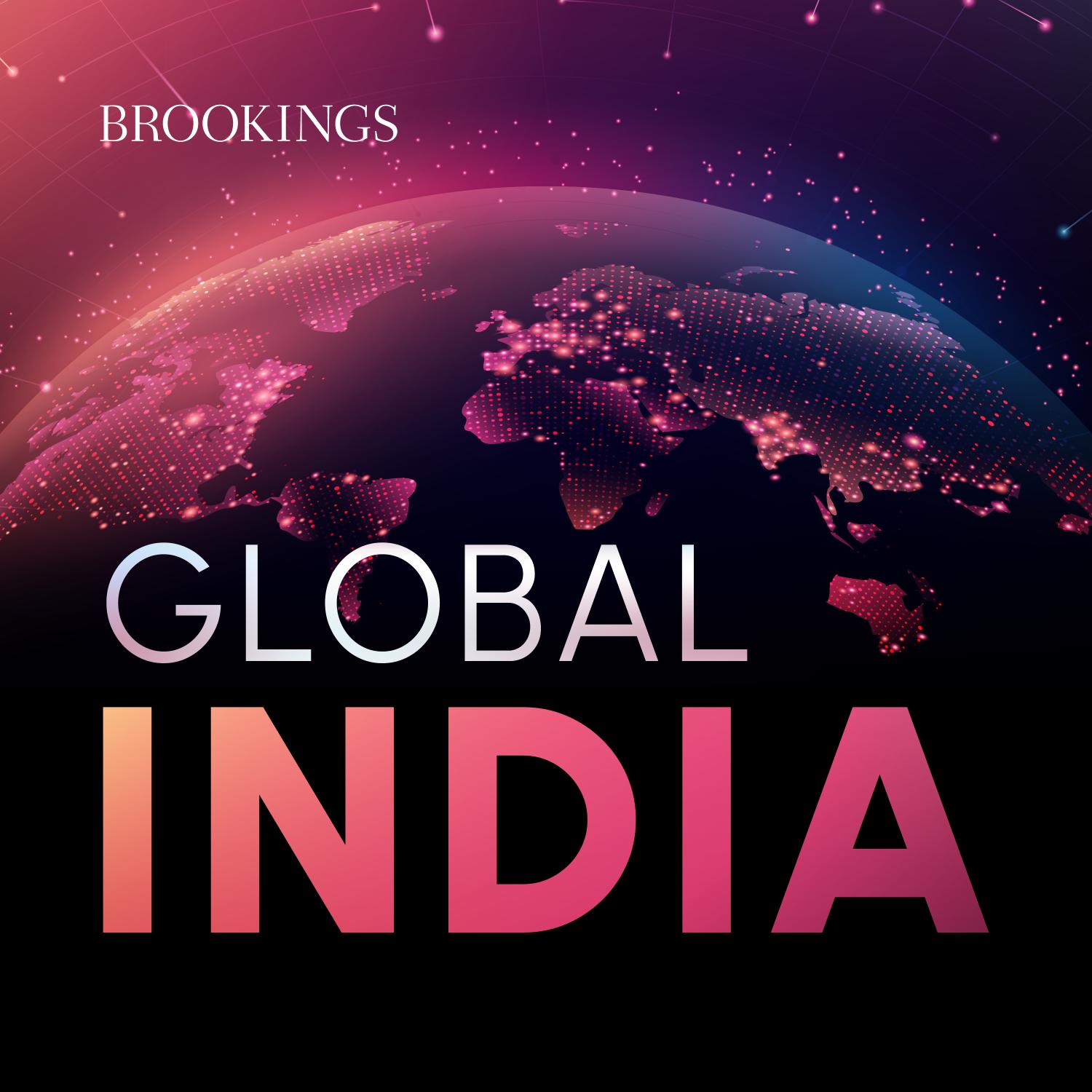
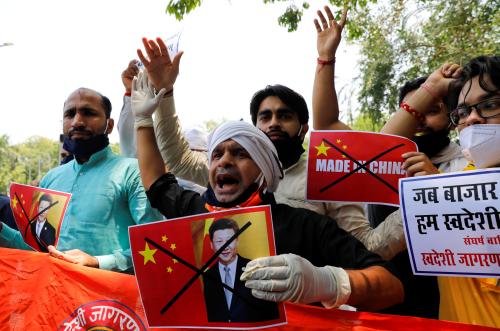
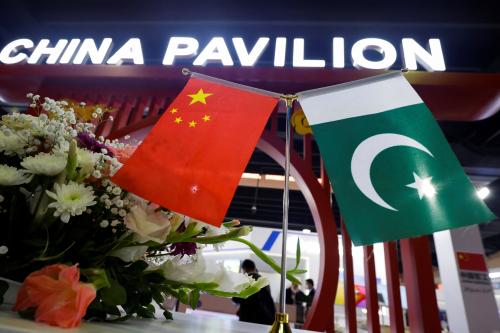




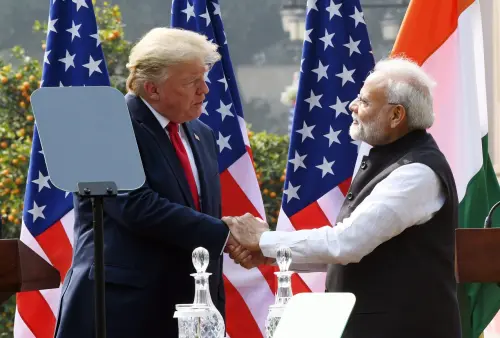
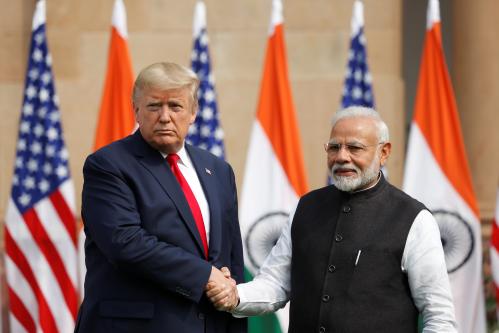

Commentary
PodcastIndia’s technology competition with China
November 29, 2023
Listen on
Global India Podcast